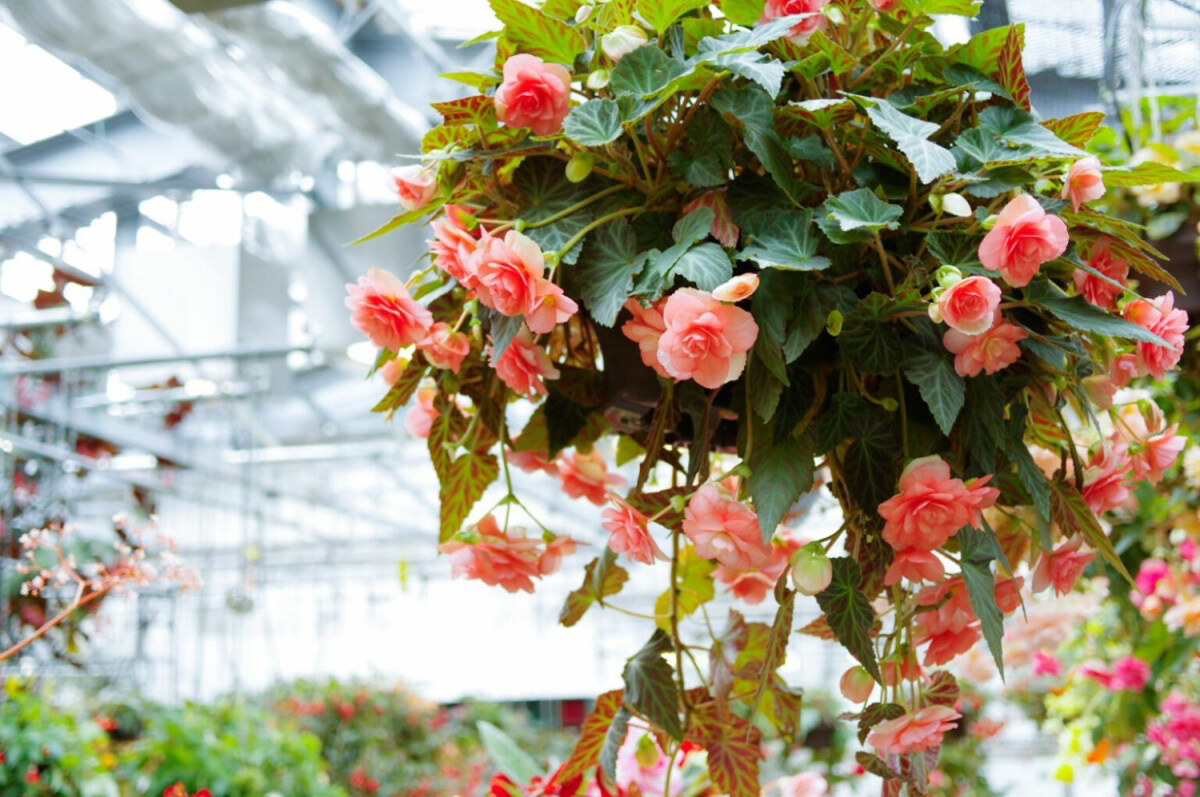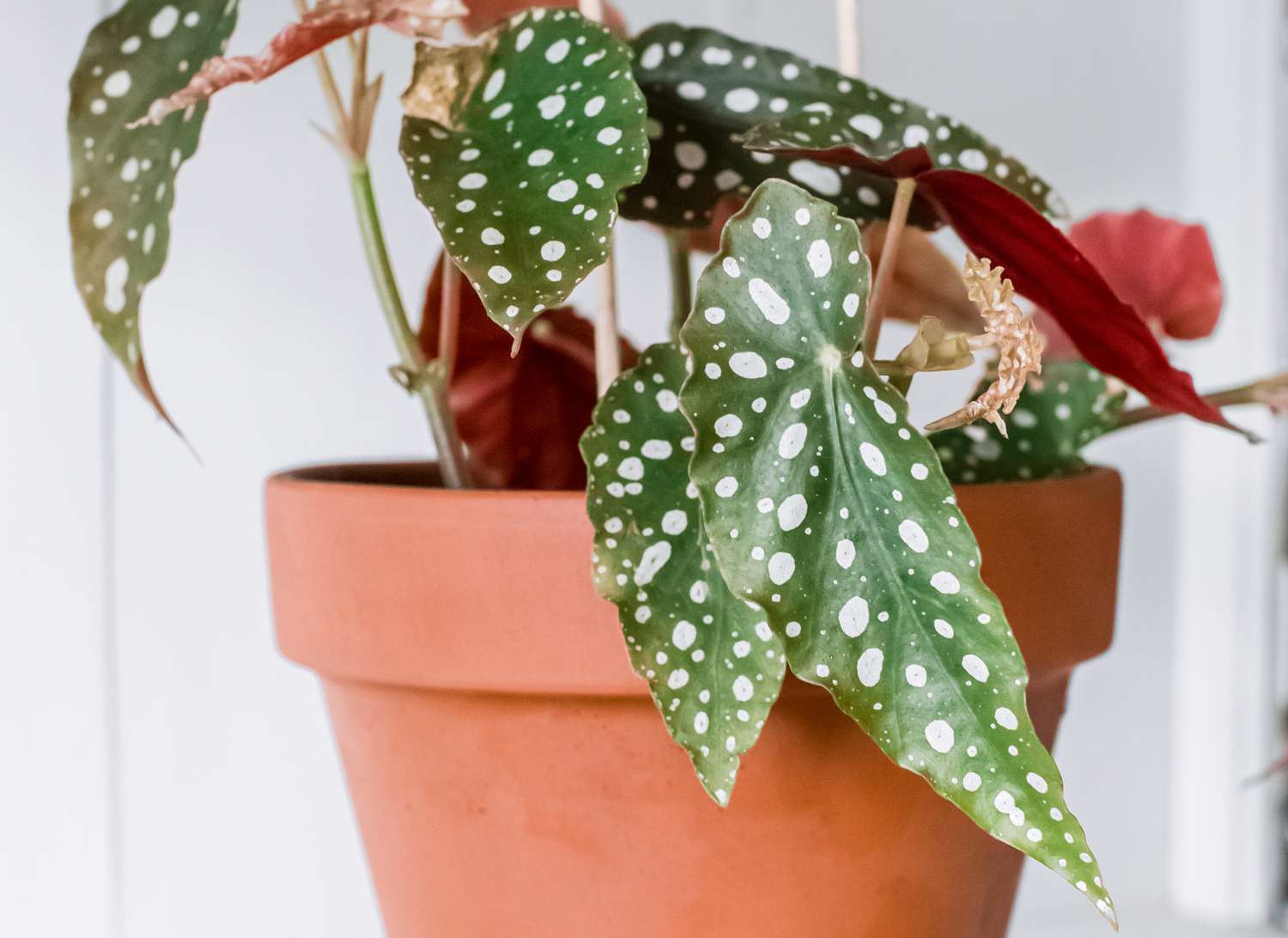Home>Lifestyle>Perennial Begonias: Unveiling The Enduring Beauty And Traits


Lifestyle
Perennial Begonias: Unveiling The Enduring Beauty And Traits
Published: February 7, 2024
Discover the enduring beauty and unique traits of perennial begonias in this lifestyle guide. Explore the timeless appeal of these stunning flowers and their impact on your outdoor space.
(Many of the links in this article redirect to a specific reviewed product. Your purchase of these products through affiliate links helps to generate commission for Noodls.com, at no extra cost. Learn more)
Table of Contents
Introduction
Perennial begonias, with their delicate blooms and vibrant foliage, are a beloved choice for gardens and landscapes. These enduring beauties have captivated the hearts of gardeners and nature enthusiasts for centuries, offering a timeless allure that transcends trends and fads. As we delve into the world of perennial begonias, we will uncover the fascinating history, diverse types, optimal growing conditions, and essential care tips for these enchanting plants.
Perennial begonias, known for their resilience and versatility, have earned a well-deserved place in the horticultural spotlight. From their humble origins to their modern-day prominence, these plants have woven themselves into the fabric of gardening culture, inspiring awe and admiration along the way. Join us on a journey through the enchanting realm of perennial begonias, where we'll explore their enduring beauty and remarkable traits.
History of Perennial Begonias
Perennial begonias have a rich and storied history that traces back to the late 17th century. The begonia genus was named in honor of Michel Bégon, a former governor of the French colony of Haiti, by the renowned botanist Charles Plumier. Plumier's discovery of these exquisite plants during his explorations in the West Indies sparked a wave of fascination, leading to the introduction of begonias to Europe.
During the Victorian era, perennial begonias experienced a surge in popularity as they became prized ornamental plants in European gardens. Their elegant blooms and striking foliage captivated the imaginations of horticulturists and garden enthusiasts, cementing their status as coveted botanical treasures.
The 19th century witnessed a significant leap in the cultivation and hybridization of perennial begonias, leading to an expansion of their varieties and colors. This era marked the emergence of tuberous begonias, which gained widespread acclaim for their dazzling flowers and adaptability to different growing conditions.
In the early 20th century, begonia breeding efforts intensified, resulting in the development of new cultivars with enhanced traits such as larger blooms, compact growth habits, and increased resistance to diseases. This era of innovation propelled perennial begonias to the forefront of horticultural fascination, solidifying their position as indispensable components of garden landscapes.
The enduring appeal of perennial begonias persisted through the decades, with ongoing advancements in breeding techniques and the introduction of novel cultivars that continue to captivate gardeners and horticultural enthusiasts worldwide. Today, these timeless plants stand as a testament to their enduring legacy, embodying a rich tapestry of history, innovation, and natural beauty.
As we admire the resplendent blooms and lush foliage of perennial begonias in modern gardens, we are reminded of their remarkable journey through time, from their discovery in distant lands to their adoration in contemporary horticulture. The history of perennial begonias is a testament to their enduring allure and the unwavering fascination they evoke in the hearts of all who encounter them.
Types of Perennial Begonias
Perennial begonias encompass a diverse array of species and cultivars, each distinguished by unique characteristics that contribute to their widespread appeal in gardens and landscapes. From the delicate elegance of the tuberous begonias to the resilient charm of the wax begonias, the world of perennial begonias offers a captivating tapestry of colors, forms, and textures.
-
Tuberous Begonias: Renowned for their show-stopping, large, and vividly colored blooms, tuberous begonias are a perennial favorite among gardeners. These begonias thrive in partially shaded areas and are prized for their ability to flourish in containers, hanging baskets, and garden beds. With varieties ranging from cascading to upright growth habits, tuberous begonias present a stunning visual spectacle, making them a cherished choice for adding a touch of opulence to any garden setting.
-
Rex Begonias: Celebrated for their striking foliage, rex begonias boast an exquisite array of intricate patterns, vibrant hues, and unique textures. These perennial begonias are treasured for their ornamental leaves, which often feature iridescent veining and captivating color combinations. Rex begonias thrive in humid and warm environments, making them ideal choices for indoor gardens and shaded outdoor spaces.
-
Cane Begonias: With their graceful, bamboo-like stems and clusters of delicate flowers, cane begonias exude an air of elegance and sophistication. These begonias are characterized by their upright growth habit and resilient nature, thriving in well-drained soil and dappled sunlight. Cane begonias are prized for their architectural presence and make stunning focal points in garden beds and borders.
-
Wax Begonias: Recognized for their resilience and prolific flowering, wax begonias are beloved for their ability to thrive in various growing conditions, including full sun and partial shade. These compact, bushy begonias produce an abundance of waxy blooms in an array of hues, adding a vibrant and cheerful touch to garden landscapes and container gardens.
-
Dragon Wing Begonias: Embraced for their vigorous growth and cascading habit, dragon wing begonias captivate with their pendulous clusters of blossoms and glossy, angel-wing-shaped leaves. These begonias are prized for their versatility, excelling as ground covers, hanging basket adornments, and vibrant accents in mixed plantings.
The diverse spectrum of perennial begonias offers a wealth of options for gardeners seeking to infuse their outdoor spaces with enduring beauty and visual allure. Whether adorning shaded nooks with their resplendent blooms or adding a touch of elegance to indoor environments with their captivating foliage, perennial begonias stand as enduring symbols of natural grace and botanical fascination.
Growing Conditions for Perennial Begonias
Perennial begonias thrive in environments that offer the ideal balance of light, moisture, and temperature. Understanding and providing the optimal growing conditions is essential for cultivating healthy and vibrant begonias in gardens, landscapes, and indoor settings.
Light Requirements
Perennial begonias exhibit a preference for filtered or indirect light, making them well-suited for shaded or partially shaded areas. When grown in regions with intense sunlight, begonias benefit from protection during the hottest parts of the day. In contrast, inadequate light can lead to leggy growth and diminished flowering. Understanding the specific light requirements of each begonia type is crucial for ensuring their optimal development and overall well-being.
Soil and Moisture
Well-drained, fertile soil with good moisture retention is essential for the successful cultivation of perennial begonias. A rich, organic potting mix that offers excellent drainage helps prevent waterlogging, which can lead to root rot and other detrimental conditions. Additionally, maintaining consistent moisture levels, avoiding overwatering, and providing adequate humidity contribute to the overall health and vigor of begonias, particularly during periods of active growth and flowering.
Temperature Considerations
Perennial begonias thrive in moderate temperatures, generally ranging from 60°F to 75°F (15°C to 24°C). While they exhibit resilience to fluctuations in temperature, they are sensitive to extreme cold and frost. Protecting begonias from harsh winter conditions, particularly in cooler climates, is essential for their survival and long-term vitality. Indoor cultivation during colder months provides a safeguard against adverse weather and ensures the continued well-being of these cherished plants.
Seasonal Adaptations
Understanding the seasonal requirements of perennial begonias is crucial for providing an environment conducive to their growth and blooming cycles. In regions with distinct seasons, adjusting care practices to accommodate the changing conditions is essential. During the dormant period, reducing watering and providing a cooler environment helps prepare begonias for their next phase of growth. As the growing season approaches, gradually increasing moisture and fertilization supports the resumption of vigorous growth and abundant flowering.
By meticulously attending to the light, soil, moisture, temperature, and seasonal nuances that influence the well-being of perennial begonias, gardeners can create an environment that nurtures these enduring beauties, allowing them to flourish and grace their surroundings with their captivating presence.
Care and Maintenance of Perennial Begonias
Caring for perennial begonias involves a blend of attentive maintenance practices and a deep understanding of their specific needs. By embracing a proactive approach to care, gardeners can ensure the longevity and vitality of these enduring beauties, allowing them to thrive and adorn their surroundings with their resplendent blooms and lush foliage.
Regular Watering and Moisture Management
Maintaining consistent moisture levels is crucial for the well-being of perennial begonias. While they appreciate adequate hydration, overwatering can lead to detrimental consequences such as root rot and fungal diseases. Striking the right balance by allowing the soil to dry slightly between watering sessions helps prevent waterlogged conditions and promotes healthy root development. During periods of active growth and flowering, vigilant monitoring of moisture levels and adjusting watering frequency based on environmental factors is essential for sustaining the vigor and vitality of begonias.
Fertilization for Optimal Growth
Providing the necessary nutrients through regular fertilization supports the robust growth and prolific blooming of perennial begonias. A balanced, water-soluble fertilizer formulated for flowering plants can be applied every two to four weeks during the growing season, enhancing the overall health and resilience of begonias. Care should be taken to follow the recommended dosage and application guidelines to prevent the risk of fertilizer burn and other adverse effects. Additionally, incorporating organic matter into the soil during the planting phase contributes to the long-term nourishment of begonias, fostering their enduring beauty and vitality.
Pruning and Deadheading
Pruning and deadheading play a pivotal role in the maintenance of perennial begonias, promoting a tidy appearance and encouraging continuous blooming. Regular removal of spent flowers and faded foliage prevents the depletion of energy resources and redirects the plant's focus towards producing new blooms. Additionally, selectively pruning leggy or overcrowded growth helps maintain a balanced and aesthetically pleasing form, enhancing the overall visual appeal of begonias. By incorporating these practices into the regular care routine, gardeners can foster a lush and vibrant display of blooms throughout the growing season.
Winter Care and Protection
As colder temperatures approach, providing adequate winter care and protection is essential for safeguarding perennial begonias from the adverse effects of frost and harsh weather conditions. In regions with chilly winters, carefully lifting the tubers and storing them in a cool, dry location offers a protective measure against potential damage. For gardeners in milder climates, applying a layer of mulch around the base of begonias helps insulate the roots and preserve their vitality during the winter months. By implementing these protective measures, gardeners can ensure the survival and resurgence of perennial begonias when the spring season heralds their return.
Vigilance Against Pests and Diseases
Vigilant monitoring for common pests such as aphids, mealybugs, and spider mites, as well as diseases like powdery mildew and botrytis, is integral to the care and maintenance of perennial begonias. Prompt identification and targeted intervention through natural or chemical remedies help mitigate the impact of infestations and diseases, preserving the health and vigor of begonias. Regular inspection of foliage, stems, and blooms enables early detection of potential issues, allowing for timely and effective remedial actions to be implemented.
By embracing a holistic approach to care and maintenance, gardeners can cultivate perennial begonias that flourish and thrive, gracing their surroundings with enduring beauty and natural charm. Through attentive nurturing and a deep appreciation for the unique traits of these captivating plants, the timeless allure of perennial begonias continues to enchant and inspire all who encounter their resplendent presence.
Common Pests and Diseases of Perennial Begonias
Perennial begonias, despite their resilience, are susceptible to a range of pests and diseases that can compromise their health and vitality. Understanding and identifying these common adversaries is essential for implementing targeted preventive measures and timely interventions to safeguard the well-being of these cherished plants.
Common Pests
Aphids:
Aphids, tiny sap-sucking insects, pose a significant threat to perennial begonias. These pests can quickly multiply and infest the tender growth tips and undersides of leaves, causing leaf distortion and stunted plant growth. Vigilant inspection and the application of natural remedies or insecticidal soaps can effectively control aphid populations, preserving the vigor and beauty of begonias.
Mealybugs:
Mealybugs, characterized by their cottony white appearance, often congregate on the stems and leaf nodes of perennial begonias, sapping their vitality and causing unsightly honeydew secretion. Regularly wiping affected areas with a damp cloth and deploying natural predators such as ladybugs help mitigate mealybug infestations, protecting the overall health of begonias.
Spider Mites:
Spider mites, minuscule arachnids that thrive in dry and warm conditions, can inflict damage to perennial begonias by piercing and sucking the chlorophyll from leaves, resulting in stippling and discoloration. Increasing humidity levels, regular misting, and the application of horticultural oils serve as effective countermeasures against spider mite infestations, preserving the lush foliage of begonias.
Common Diseases
Powdery Mildew:
Powdery mildew, a fungal disease characterized by powdery white patches on leaves, stems, and flowers, can affect perennial begonias, particularly in humid and crowded growing conditions. Adequate air circulation, spacing between plants, and the application of fungicidal sprays help prevent and manage powdery mildew, safeguarding the overall health and aesthetic appeal of begonias.
Botrytis:
Botrytis, also known as gray mold, can afflict perennial begonias, especially during periods of high humidity and excessive moisture. This fungal disease manifests as grayish-brown lesions on leaves and flowers, posing a risk to the vitality of begonias. Implementing proper sanitation practices, such as removing decaying plant material, and providing adequate ventilation aids in preventing and controlling botrytis, ensuring the resilience of begonias.
By remaining vigilant and proactive in addressing common pests and diseases, gardeners can nurture perennial begonias that thrive and flourish, unfurling their resplendent blooms and captivating foliage without the encumbrance of detrimental adversaries. Through a harmonious balance of attentive care and targeted interventions, the enduring beauty of perennial begonias continues to grace gardens and landscapes, captivating all who behold their timeless allure.
Uses of Perennial Begonias in Landscaping
Perennial begonias, with their enduring beauty and versatile traits, serve as invaluable assets in the realm of landscaping, offering a myriad of applications that elevate outdoor spaces with their captivating presence. From adding vibrant splashes of color to creating lush ground covers, perennial begonias are esteemed for their ability to infuse landscapes with natural grace and visual allure.
1. Ornamental Bedding Displays
Perennial begonias, with their diverse array of colors and forms, are prized for their role in ornamental bedding displays. Their compact growth habits and prolific flowering make them ideal candidates for creating captivating arrangements in garden beds and borders. Whether utilized as focal points or interspersed among complementary plants, begonias lend a touch of elegance and vibrancy to landscaping compositions, enhancing the visual appeal of outdoor environments.
2. Shaded Garden Nooks
In shaded or partially shaded areas of the landscape, perennial begonias thrive, making them invaluable for embellishing garden nooks and secluded corners. Their preference for filtered light and moderate temperatures allows them to flourish in spaces that may pose challenges for other plants. By adorning shaded alcoves and tranquil retreats with their resplendent blooms and lush foliage, begonias infuse these areas with an enchanting ambiance, creating inviting havens within the landscape.
3. Container Gardens
The versatility of perennial begonias extends to their suitability for container gardening, where they serve as striking focal points in patio displays, balcony arrangements, and courtyard adornments. Their adaptability to container environments, coupled with their ability to thrive in partially shaded conditions, makes them coveted choices for adding visual interest and natural charm to outdoor living spaces. Whether cascading from hanging baskets or adorning decorative pots, begonias bring a touch of botanical elegance to container gardens, enhancing the aesthetic appeal of urban and suburban landscapes.
4. Edging and Borders
The compact and mounding growth habits of certain perennial begonias make them well-suited for edging pathways, defining borders, and delineating garden spaces. Their lush foliage and continuous flowering create a seamless transition between different landscape elements, imparting a sense of cohesion and refinement to outdoor settings. By incorporating begonias into edging schemes, landscapers can establish harmonious delineations and visually captivating transitions within the garden layout.
5. Understory Plantings
In woodland gardens and shaded landscapes, perennial begonias function as invaluable understory plantings, enriching these environments with their enduring beauty and natural resilience. Their preference for filtered light and moist, well-drained soil aligns with the conditions prevalent in understory settings, allowing begonias to thrive beneath the canopy of trees and alongside companion plants. By integrating begonias into understory plantings, landscapers can introduce vibrant bursts of color and lush foliage to these tranquil woodland retreats, enhancing their allure and natural charm.
6. Mixed Plantings and Combinations
Perennial begonias harmonize seamlessly with a diverse array of companion plants, offering endless possibilities for creating captivating mixed plantings and combinations within the landscape. Their vibrant blooms and captivating foliage serve as versatile elements that complement and enhance the visual impact of neighboring plants. Whether intermingled with ferns, hostas, or other shade-loving perennials, begonias contribute to the creation of dynamic and visually engaging compositions that enrich the landscape with their enduring beauty.
7. Ephemeral Displays
Perennial begonias, when utilized in seasonal displays and ephemeral garden arrangements, add a touch of seasonal splendor to the landscape. Whether incorporated into temporary plantings for special events, garden celebrations, or seasonal transformations, begonias infuse these displays with their resplendent blooms and captivating foliage, creating memorable and visually enchanting spectacles within the landscape.
In summary, the uses of perennial begonias in landscaping are as diverse as the plants themselves, encompassing a wide range of applications that enrich outdoor environments with enduring beauty, natural grace, and visual allure. From ornamental bedding displays to shaded garden nooks, container gardens, and beyond, perennial begonias stand as indispensable elements that enhance the landscape with their captivating presence, perpetuating their timeless allure in the realm of landscaping.
Conclusion
In conclusion, the enduring beauty and remarkable traits of perennial begonias have solidified their status as cherished components of gardens, landscapes, and indoor settings. From their storied history to their diverse types, optimal growing conditions, and essential care practices, perennial begonias have captivated the hearts of gardeners and nature enthusiasts for centuries. Their resilience, versatility, and capacity to infuse outdoor spaces with vibrant splashes of color and natural charm have established them as indispensable elements in the realm of horticulture.
The rich history of perennial begonias, spanning centuries of cultivation and hybridization, serves as a testament to their enduring allure and unwavering fascination. From their discovery in distant lands to their adoration in contemporary horticulture, the journey of perennial begonias reflects a tapestry of innovation, natural beauty, and timeless appeal. As we admire their resplendent blooms and lush foliage in modern gardens, we are reminded of the enduring legacy and captivating allure of these remarkable plants.
The diverse spectrum of perennial begonias, ranging from tuberous and rex begonias to cane, wax, and dragon wing varieties, offers a wealth of options for gardeners seeking to infuse their outdoor spaces with enduring beauty and visual allure. Whether adorning shaded nooks with their resplendent blooms or adding a touch of elegance to indoor environments with their captivating foliage, perennial begonias stand as enduring symbols of natural grace and botanical fascination.
Understanding and providing the optimal growing conditions for perennial begonias, including light, soil, moisture, temperature, and seasonal adaptations, is essential for cultivating healthy and vibrant plants. By meticulously attending to these factors, gardeners can create an environment that nurtures these enduring beauties, allowing them to flourish and grace their surroundings with their captivating presence.
The care and maintenance of perennial begonias involve a blend of attentive practices, including regular watering, fertilization, pruning, winter care, and vigilance against pests and diseases. By embracing a proactive approach to care, gardeners can ensure the longevity and vitality of these enduring beauties, allowing them to thrive and adorn their surroundings with their resplendent blooms and lush foliage.
In landscaping, perennial begonias serve as invaluable assets, offering a myriad of applications that elevate outdoor spaces with their captivating presence. From ornamental bedding displays to shaded garden nooks, container gardens, edging, understory plantings, mixed combinations, and ephemeral displays, perennial begonias enrich the landscape with enduring beauty, natural grace, and visual allure.
In essence, the timeless allure of perennial begonias continues to enchant and inspire all who encounter their resplendent presence. Their enduring beauty, remarkable traits, and versatile applications in horticulture and landscaping underscore their significance as beloved botanical treasures that continue to captivate and enrich the natural world.









